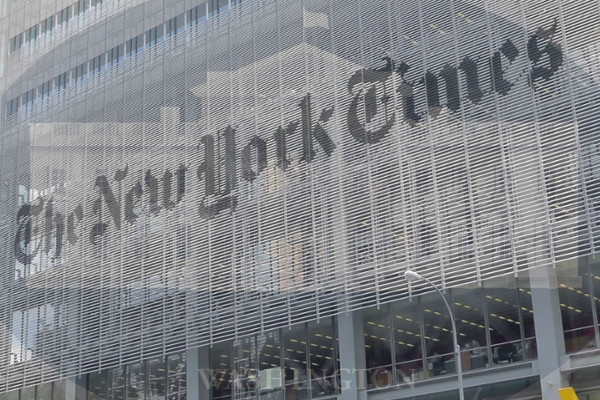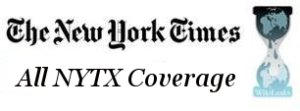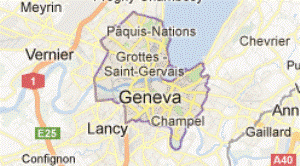EUROPE » TRUTH ADDICT
The New York Times Excoriates ‘Aggression’: The Washington Exception
March 5, 2014 · 0 Comments

Above: Photo and collage by NYT eXaminer.
By Michael M'Gehee:
Over the last quarter century the New York Times' Editorial board has made editorial decisions that illustrate a peculiar pattern. Times readers could otherwise overlook the pattern in everyday reading. However, when viewed through a wider historical lens, the pattern lays bare biased reporting that should concern readers.
In five editorial pieces, spanning a period from December 1989 to March 2014, and encompassing nearly 3,000 words, the Times’ Editorial board has weighed in on cross-border military actions. The selectivity of their language shows a political bias in favor of upholding what they believe is best for Washington’s interests and therefore, under the guise of “objectivity,” report expectedly in opposition to Washington's adversaries.
In their December 1989 editorial on the U.S. invasion of Panama—“Why the Invasion Was Justified”—the Times tells readers that even though the invasion “has fueled enduring Latin suspicions about Washington's selective respect for sovereignty” the invasion was justified because President Bush “turned to military force only as a last resort.” The evidence for this? The Editors wrote that, “Mindful of Latin sensitivity to unilateral U.S. intrusions, the Administration sought multilateral action through the Organization of American States, to little avail.” [1]
Despite substantial lack of proof to convince the members of the OAS, an organization which has no authority to justify military force anyway, Washington carried out an illegal invasion. By claiming that President Bush deployed military force as a last resort, the Times provided cover for then President Bush’s effort to undermine the legal resolution of the issue at the UN Security Council.
The Times reported that same December, “The United States, Britain and France used their vetoes as permanent members of the Security Council today to block a resolution criticizing the American invasion of Panama, although a majority of the Council's 15 members voted in favor.” [2]
The only remaining argument put forward by the Times was that of protecting “the integrity of the Panama Canal treaties.” Hardly an example of a “justified” invasion.
A decade later in March of 1999, the Times returned with “Air Campaign Against Yugoslavia” telling their readers that, “The air attacks are fully warranted.” As with Panama, the supporting argument was built on misinformation. [3]
“Yugoslavia's President, Slobodan Milosevic, has” the Editors wrote, “rejected all efforts at meaningful diplomacy and, in violation of his own previous commitments, has ratcheted up his military campaign against the innocent civilians of Kosovo.”
While the phrase "meaningful diplomacy" is convoluted, the problem with the Editors' comment in this case was as Noam Chomsky pointed out in the aftermath of the bombing:
The [Organization for Security and Co-operation in Europe] inquiry conforms closely to the indictments produced by the State Department and the Tribunal. It records “the pattern of the expulsions and the vast increase in lootings, killings, rape, kidnappings and pillage once the NATO air war began on March 24.” “The most visible change in the events was after NATO launched its first airstrikes” on March 24, the OSCE reports. [4]
Times’ Editors described an illegal bombing campaign as “warranted” on the grounds that it put a stop to the very thing the bombing provoked and exacerbated.
More troubling, at least in retrospect, is that John Norris—a senior Clinton official who was party to the tripartite negotiations led by Deputy Secretary of State Strobe Talbott— wrote in his eyewitness account Collision Course: NATO, Russia, and Kosovo, "It was Yugoslavia’s resistance to the broader trends of political and economic reform—not the plight of Kosovar Albanians—that best explains NATO’s war."
Four years later the Editorial board carried the pattern forward with their editorial “The War Begins.” While not as supportive of the Iraq War, the Editors refrain from criticizing the war, and instead note that, “This is now, as Mr. Bush has said repeatedly, a war with two missions: disarming Iraq and then transforming it into a free and hopeful society. That second goal is also an end everyone would like to see.” [5]
But this attitude towards American cross-border military action—which is at times ambivalent, though otherwise supportive—does not hold when applied to another country, especially that of Russia, whose growing influence at a time of waning American power could, many commentators argue, provoke a new Cold War.
In their August 2008 editorial “Stuck in Georgia,” Times Editors wrote that it was Prime Minister Vladimir Putin who was “the dark hand behind Russia’s aggression.” [6]
On August 7 of that year Georgia attacked South Ossetia, which lies between Russia and Georgia. Although it was Georgia that launched the war, the Western news media, the New York Times included, reflexively accused Russia of aggressing against Georgia, rather than Georgia aggressing against South Ossetia. In less than ten days, Georgian forces were routed by the Russian military, South Ossetian forces, and forces from Abkhazia, another regional Russian ally.
And six years later the Times, in ratchet-step like consistency, provided yet another excoriation of “Russia's Aggression,” this time on “Vladimir Putin's cynical and outrageous exploitation of the Ukrainian crisis to seize control of Crimea.” [7]
While we here at the NYTimes eXaminer have already noted the Times' poor coverage of the politics of the Ukranian protests that led to the overthrow of President Viktor Yanukovych, in what the Times explained was achieved rather “hurriedly,” there are other things missing in this editorial that do not fit well with the notion of “aggression.” [8]
President Yanukovych, however problematic -- the only democratically-elected president -- asked Russia for help, as has been reported. [9]
This is an important fact to keep in mind because, along with the fact that the incursion happened without a single fatality (and only one casualty: a concussion) and was limited to the historically Russian peninsula home to nearly three times as many ethnic Russians as Ukranians, a government asking another government for military help, and that latter government confining its involvement to securing the only location that is conceivably within its interests to protect, it is quite a stretch to call Russia's deployment of troops “aggression.”
On top of it all, Crimeans have largely welcomed the presence of Russian troops, as Deutsch Welles reported in their article, "Pro-Russian Crimeans welcome Moscow's decision to send troops." [10]
Furthermore, it is strange to read the Times explaining that the U.S. government is “justified” to invade Panama in order to “safeguard the lives of Americans,” but then say for Russia that “Mr. Putin's claim of an immediate threat to Ukrainian Russians is empty.”
Unlike Ukraine, where neo-Nazi militants openly declare "I'll be fighting Jews and Russians till I die," no such rhetoric existed in Panama in 1989. [11]
Also missing from the Times’ editorial is the fact that in numerous cities around Ukraine protesters, who are diverse and want better lives, have taken over government buildings to fly the Russian flag and are asking Moscow to defend them from the new interim-government that includes far-right wing and fascist forces such as Svoboda. The Times’ reporting is consistent with Wahsington’s efforts to undermine Russia’s sphere of influence, where Russian President Vladimir Putin wants the Ukraine to join the “Eurasian Union” in 2015. Offering what they believe is best for Washington’s interests, Times editors report in favor of a pro-European Ukraine even if the majority of Ukrainians themselves may want something else.
While there are Ukrainians who are against Russia’s presence in Crimea, Reuters reports that, “Demonstrators flew Russian flags on government buildings in the cities of Kharkiv, Donetsk, Odessa and Dnipropetrovsk,” and that “Pro-Russian demonstrators wielded axe handles and chains against those defending the building with plastic shields.” [12]
BBC reported that the “New head of Ukraine's navy defects in Crimea.” This coincides with RT's report which explained, “Ukraine’s Navy flagship, the Hetman Sahaidachny frigate, has reportedly refused to follow orders from Kiev, and come over to Russia’s side and is returning home after taking part in NATO operation in the Gulf of Aden flying the Russian naval flag.” [13] [14]
Many reports have offered a counter-view to the Times’ perception that “nowhere were Russian speakers or Russian interests seriously threatened — certainly not in Crimea,” and that, “If anything, Ukrainians there were in danger.” For example, RT also reported that “Ukrainian special forces regiment joins other units in refusal to march against Crimea.” This should be read along with the report that the conscription ordered by what could be described as the coup-government in Kiev has been met with an extremely low turnout (1-1.5%). [15] [16]
Additionally, Forbes magazine reported that “upwards of 675,000 Ukrainians have hightailed it out of the southeastern part of Ukraine between January and February,” as well as that “On Saturday, Russian migration authorities reported that 143,000 requests for asylum had been sent to Russia within a two-week period.” [17]
These developments coming out of Ukraine—of appointees defecting to Moscow, of soldiers refusing to follow orders from Kiev, of conscripts refusing to show up, of protesters flying Russian flags, and of hundreds of thousands of Ukrainians fleeing depicts an image of a country that does not look forward to the new future that right-wing parties like Svoboda have in store for them, where segments of civil and political society are alternatively turning to Russia for assistance. The New York Times offers its readers Washington’s political line when they describe Russia’s role, which certainly has its own interests, as “aggression.”
Table 1. Five Theaters of Cross-Border Military Action, by State Conducting the Operation, as addressed by New York Times Editorials
| Cross-border military action | By the United States | By Russia |
| Against Panama, December 1989 | “Mr. Bush was not obliged to act yesterday, but he was justified in doing so.” [1] | |
| Against the Federal Republic of Yugoslavia (Kosovo province),March 1999 | “The air attacks are fully warranted.” [3] | |
| Against Iraq, March 2003 | “This is now, as Mr. Bush has said repeatedly, a war with two missions: disarming Iraq and then transforming it into a free and hopeful society. That second goal is also an end everyone would like to see.” [5] | |
| Against Georgia (South Ossetia and Abkhazia), August 2008 | “Prime Minister Vladimir Putin, the dark hand behind Russian aggression….” [6] | |
| Against the Ukraine, March 2014 | “President Obama did well in his phone call with Mr. Putin to combine conciliatory references to Russia's valid interests in Ukraine and the need for dialogue with the threat that continued aggression will result in ‘greater political and economic isolation’.'' [7] |
New York Times’ Editors seem more than willing to accuse Russia of “aggression” (despite that in 2008 it was Georgia who started the war, and that it was the legitimate government in Ukraine who asked for help), even when the argument is deficient. But they temper such rhetoric when it comes to Washington, when the term is more fitting. U.S. Secretary of State John Kerry made the disparity in language clear when he threatened and criticized Russia. Kerry told Moscow, "You just don’t invade another country on phony pretext in order to assert your interests." Times’ Editors fail to ridicule Washington’s double standards, and instead demonstrate the efficacy of our propaganda system where the leading “paper or record” presents itself as publishing "all the news fit to print." [18]
Sources:
[1] “Why the Invasion Was Justified,” Editorial, New York Times, December 21, 1989.
[2] "Fighting in Panama: United Nations; Security Council Condemnation of Invasion Vetoed," Paul Lewis, New York Times, December 24, 1989.
[3] “Air Campaign Against Yugoslavia,” Editorial, New York Times, March 25, 1991.
[4] "A Review of NATO’s War over Kosovo," Noam Chomsky, Z Magazine, April-May 2001
[5] “The War Begins,” Editorial, New York Times, March 20, 2003.—It should be noted that New York Times editorials (of which there were a total of 25 between March 19 and 31, 2003, that either touched on or focused exclusively on the war against Iraq) were generally evasive about the justness of the war.
[6] “Stuck in Georgia,” Editorial, New York Times, August 27, 2008.
[7] “Russia’s Aggression,” Editorial, New York Times, March 3, 2014.
[8] "What’s Missing From the NYT’s Coverage of Protests in Ukraine?," Michael M'Gehee, NYTimes eXaminer, January 28, 2014.
[9] "Lawmaker: Yanukovych asks Russian parliament to help Crimea," Kyiv Post, March 2, 2014.
[10] "Pro-Russian Crimeans welcome Moscow's decision to send troops," Mikhail Bushuev, Deustch Welles, March 2, 2014.
[11] "'I'll be fighting Jews and Russians till I die': Ukrainian right-wing militants aiming for power," RT, February 22, 2014.
[12] "Putin ready to invade Ukraine; Kiev warns of war," Lidia Kelly and Pavel Polityuk, Reuters, March 1, 2014.
[13] "New head of Ukraine's navy defects in Crimea," BBC, March 2, 2014.
[14] "Ukrainian Navy flagship takes Russia’s side – report," RT, March 1, 2014.
[15] "Ukrainian special forces regiment joins other units in refusal to march against Crimea," RT, March 3, 2014.
[16] "Turnout in the first day of reservists mobilization in Ukraine is very low," Gazeta, March 2, 2014.
[17] "As Crimea Crisis Unfolds, Russia Facing Potential Ukrainian Refugee Crisis," Kenneth Rapoza, Forbes, March 2, 2014.
[18] "Seriously, what?! Kerry tells Russia 'you don't invade a country on completely phony pretexts'," RT, March 3, 2014.
Note: David Peterson, Chicago-based researcher and coauthor of The Politics of Genocide, contributed greatly to this article










Sorry, comments are closed on this post.